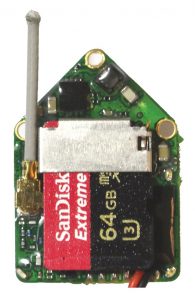MouseLog16 is a lightweight wireless neural logger. It provides 16 channels of neural signal recording and is optimized for extracellular spike recording. Its signal bandwidth is 7kHz and it digitizes the signal from each channel at 31250 samples per second.

MouseLog-16 wieghs 1.9 grams including its memory card, antenna and battery connection lead. Generally it is operated with a 1.6g battery, though lighter or heavier batteries ca be used where minimal weight or longer recording times are needed. Thus the total typical weight is about 3.5g
Click here to download the original MouseLog-16 flier.
Since the original MouseLog-16 was introduced in 2015, some other few variants have become available:
The LFP version if the MouseLog16 has different internal software and is optimized for recording of local field potential (LFP) signals. It has a 16-channel connector, but the user selects 8 of the 16 channels for recording. The current consumption of this version is about one third of that of the standard version, so it can record LFP signals for about 6 hours with a 1.6g battery. Its bandwidth is 500Hz, and it digitizes each of 8 channels at 4000 samples per second with 16-bit resolution.

The vertical version was optimized for spike logging on freely flying bats. It mounts vertically rather than horizontally, so that it will not obstruct the rising wings of the bats.
The new version MouseLog-16 is called MouseLog16B. It is identical in size and shape to the original model but is prepared for some significant software enhancements that will be introduced in 2018. New orders for MouseLog-16 are now supplied as MouseLog-16B.
Enhancements that the MouseLog-16B offers over the original version are:
- An extra pair of omnidirectional LEDs to aid camera tracking
- Four options (1Hz, 10Hz, 60Hz or 300Hz) for the lower frequency frequency signal limit replace the previous two (1Hz or 300Hz)
- Contacts provided to provide power for external tracking LEDs
- Reference channels allow at least one reference channel per tetrode
- Conformally clad with transparent epoxy to provide protection from liquids and damage from impact
- Provision for the following forthcoming software enhancements
- Wired connection for 12-channel continuous signal preview or data streaming
- 16-bit digitization option for spike mode
- Switchable by the user between LFP and spike mode
- Low power stand-by mode
